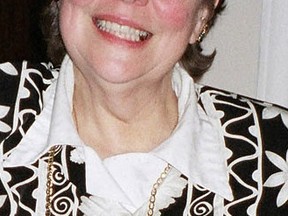The World is a Stage

Article content
I recently had a message, relayed from the Tillsonburg News, from a reader who wanted to know the history behind some of our street names in Tillsonburg. Thank you, oh nameless one, it is a great idea.
George Tillson, our beloved founder, had a thing for roads. He plotted out our streets and made sure all nearby roads would come to our town. He named the roads going out of town, to the destination they were headed.
Therefore we had Ingersoll-Pt. Burwell Road, which became Plank and Gravel Road, which became Hwy 19 and Plank Rd. Simcoe Street goes to Simcoe. London Street was supposed to go to London. And John Pound Road headed off towards Aylmer, ending up at John Pound’s farm. John was a Quaker and owned Conc. 8 Lot 30 and Conc. 9, Lot 30. It is on the 1877 County Atlas.
Other researchers have said George’s politics leaned towards the reformers and he named his streets after some including Lord Durham, the father of responsible government who recommended the union of Upper and Lower Canada, and Lord Earl Elgin, who was a ‘neutral’ Governor-General of British North America (1847-54).
Sir John Young became Baron Lisgar, our second Governor General of Canada. While in office, Manitoba (1870) and British Columbia (1871) joined Confederation.
Thomas Ridout, also a Reformer, was a prominent member of Upper Canada society.
Dr. John Rolph, another Reformer, was a physician as well as a member of the Legislative assembly of Upper Canada for several areas. He was exiled for his part in 1837 Rebellion, but returned to Canada and established the Toronto School of Medicine. He also trained two physicians who moved to town and are buried in the Pioneer Graveyard.
Brock Street is named after one of Canada’s first heroes, Sir Isaac Brock, for his efforts in saving Upper and Lower Canada in the War of 1812.
King and Queen Streets are self explanatory, as are Bear, Venison, and Wolf. And don’t forget Fox, Coon and Cat Alley (not for pretty domestic cats but for our large wild cats like bobcats, cougars and lynx).
Dr. Charles Van Dyke Corless purchased Annandale House in 1928, renovating and renaming it Coniston Place, to celebrate his own mining success in Sudbury. Corless Lane is the alley behind the house.
Other streets marked the town boundaries or locations, like Concession Street, Quarter Town Line Road, and North Street. We had Market Square, where the fresh market produce was sold and later where our Town Hall and now downtown mall are located.
Bloomer Street was our first main street, named after the Bloomery Forge, the style of forge that George built when he arrived in 1825. Harvey Tillson donated the land on the street named after him, for the still standing Avondale Presbyterian Church. He was a grandson of founder George.
Washington Grand Ave. was truly a grand avenue! It was very wide and eventually our library was built in the middle of the road. It crossed Broadway and ended at Market Square, later the Town Hall.
Vienna Woods was first growth forest, with very tall trees letting little to no light to the forest floor. It was to the south of Simcoe Street where today we have Vienna Road.
Joseph Matthias Sanders was a mover and shaker in town and I am guessing he is the Sanders for which it was named. E.W. and J.S. Hyman were owner and tanners of the Hyman Tannery on Cranberry Road. No proof, but I was once told Cranberry Road was named as it went through a cranberry marsh! Cranberry road is now Tillson Ave., and you all know who that was named after.
Potters Road was named for David Potter, a mill owner in what was then South Norwich Township. (I had always thought it was from a pottery.)
When the train tracks crossing Broadway were removed, the overhead bridge, also known as the launch pad, was removed and the replacement road (Bridge Street) named in its honour.
We have subdivisions named after developers' families, others for birds, flower, and mayors, etc. Today’s by-laws state that, “naming of roads and subdivisions for the municipality should be determined in a manner that incorporates local history, culture and environmental features.”
If anyone knows of any other explanations for naming our streets and roads, please let me know.